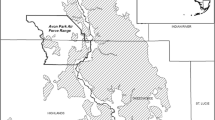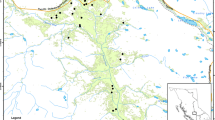Abstract
Native unploughed tallgrass prairie from Konza Prairie, Kansas, USA is described with respect to plant species compositional changes over a five year period in response to fire and topography. The principal gradient of variation in the vegetation is related to time since burning. Species show an individualistic response in terms of relative abundance to this gradient. Both the percentage of and cover of C4 species and all grasses decrease as the prairie remains unburnt. Forb and woody plant species numbers and abundance increase along this gradient. A secondary gradient of variation reflects topography (i.e. upland versus lowland soils). Upland soils support a higher species richness and diversity. Upland and lowland plant assemblages are distinct except on annually burnt prairie. The interaction between burning regime, topography and year-to-year climatic variation affects the relative abundance of the plant species differentially. The most dominant species overall, Andropogon gerardii, was affected only by year-to-year variation (i.e. climate). Its position at the top of the species abundance hierarchy was unaffected by burning regime or soil type. The other dominant species showed a suite of varying responses to these factors.
Similar content being viewed by others
References
Abrams M. D. & Hulbert L. C. 1987. Effect of topographic position and fire on species in tallgrass prairie in northeast Kansas. Am. Midl. Nat. 117: 442–445.
Abrams M. D., Knapp A. K. & Hulbert L. C. 1986. A ten-year record of aboveground biomass in a Kansas tallgrass prairie: effects of fire and topographic position. Amer. J. Bot. 73: 1509–1515.
Allen T. F. H. & Wyleto E. P. 1983. A hierarchical model for the complexity of plant communities. J. Theor. Biol. 101: 529–540.
Allen T. F. H. & Hoekstra T. W. 1986. Description of complexity in prairies through hierarchy theory. In: G. K. Clambey & R. H. Pemble (eds), Proc. Ninth. N. Amercian Prairie Conf. 71–73. Tri-College University Center for Environmental Studies, North Dakota State University, Fargo.
Anderson K. L., Smith E. F. & Owensby C. E. 1970. Burning bluestem range. J. Range Mangt. 23: 81–91.
Axelrod D. I. 1985. Rise of the grassland biome, central North America. Bot. Rev. 51: 163–201.
Barnes P. W. & Harrison A. T. 1982. Species distribution and community organization in a Nebraska Sandhills mixed prairie as influenced by plant/soil-water relationships. Oecologia (Berl.) 52: 192–201.
Bazzaz F. A. & Parrish J. A. D. 1982. Organization of grassland communities. In: J. R. Estes, R. J. Tyrol & J. N. Brooks (eds), Grasses and Grasslands: Systematics and Ecology, 233–254. The University of Oklahoma Press, Norman, OK, USA.
Belsky A. J. 1983. Small-scale pattern in grassland communities in the Serengeti National Park, Tanzania. Vegetatio 55: 141–151.
Belsky A. J. 1986a. Revegetation of artificial disturbances in grasslands of the Serengeti National Park, Tanzania. I. Colonization of grazed and ungrazed plots. J. Ecol. 74: 419–438.
Belsky A. J. 1986b. Revegetation of artificial disturbances in grasslands of the Serengeti National Park, Tanzania. II. Five years of successional change. J. Ecol. 74: 937–951.
Bliss L. C. & Cox G. W. 1964. Plant community and soil variation within a Northern Indiana Prairie. Amer. Midl. Nat. 72: 115–128.
Bragg T. B. & Hulbert L. C. 1976. Woody plant invasion of unburned Kansas bluesterm prairie. J. Range Mgt. 29: 19–24.
Chang D. H. S. & GauchJr. H. G. 1986. Multivariate analysis of plant communities and environmental factors in Ngari, Tibet. Ecology 67: 1568–1575.
Clément B. & Touffet J. 1981. Vegetation dynamics in Brittany heathland after fire. Vegetatio 46: 157–166.
Collins S. L. 1987. Interaction of disturbance in tallgrass prairie: a field experiment. Ecology 68: 1243–1250.
Collins S. L. & Adams D. E. 1983. Succession in grasslands: Thirty-two years of change in a central Oklahoma tallgrass prairie. Vegetatio 51: 181–190.
Collins S. L. & Barber S. C. 1985. Effects of disturbance in mixed-grass prairie. Vegetatio 64: 87–94.
Daubenmire R. F. 1968. The ecology of fire in grasslands. Adv. Ecol. Res. 5: 209–266.
Ehleringer J. R. 1978. Implication of quantum yield differences in the distribution of C3 and C4 grasses. Oecologia (Berl.) 31: 255–267.
Gibson D. J., Johnson F. L. & Risser P. G. 1985. Revegetation of unreclaimed coal strip mines in Oklahoma. 2: Plant communities. Reclamation & Revegetation Research 4: 31–47.
Gibson D. J. & Greig-Smith P. 1986. Community pattern analysis: A method for quantifying community mosaic structure. Vegetatio 66: 41–47.
Gleason H. A. 1926. The individualistic concept of plant association. Bull. Torrey Bot. Club 53: 7–26.
Glenn-Lewin D. C. 1980. The individualistic nature of plant community development. Vegetatio 43: 141–146.
Greenland D. (ed.) 1987. The climate of long-term ecological research sites. INSTAAR, Occ. Paper 44. University of Colorado, Boulder, Colorado.
Hill M. O. 1979. DECORANA — a FORTRAN program for detrended correspondence analysis and reciprocal averaging. Ecology and Systematics, Cornell University, Ithaca, New York.
Hill M. O. & Gauch H. G. 1980. Detrended correspondence analysis: an improved ordination technique. Vegetatio 42: 47–58.
Hobbs R. J. & Gimingham C. H. 1984. Studies on fire in Scottish heathland communities. I. Fire characteristics. J. Ecol. 72: 223–240.
Hulbert, L. C. 1973. Management of Konza Prairie to approximate pre-white-man fire influences. In: L. C. Hulbert (ed.), Proc. 3rd Midwest Prairie Conf., Kansas State University, Manhattan, KS.
Hulbert L. C. 1985. History and use of Konza Prairie Research Natural Area. Prairie Scout 5: 63–93.
Hulbert L. C. 1986. Fire effects on tallgrass prairie. In: Clambey G. K. & Pemble R. H. (eds), Proc. Ninth N. American Prairie Conf., 38–42. Tri-College University Center for Environmental Studies, North Dakota State University, Fargo.
Hulbert, L. C. in press. Causes of fire effects in tallgrass prairie. Ecology.
Knapp A. K. 1984. Water relations and growth of three grasses during wet and drought years in a tallgrass prairie. Oecologia 65: 35–43.
Knapp A. K. & Hulbert L. C. 1986. Production, height and density of flowering stalks of three grasses in annually burned and unburned eastern Kansas tallgrass prairie: a four year record. Southwestern Nat. 31: 235–242.
Knapp A. K. & Seastedt T. R. 1986. Detritus accumulation limits productivity of tallgrass prairie. BioScience 36: 662–668.
Kucera, C. L. 1981. Grassland and fire. In: Mooney, H. A., Bonnicksen, T. M., Christensen, N. L., Lotan, J. E. & Reiners, W. A. (eds), Fire regimes and ecosystem properties, pp. 90–111. USDA For. Serv. Gen. Tech. Rep. WO-26.
Levins R. & Lewontin R. 1980. Dialectics and reductionism in ecology. In: Saarinen E. (ed.), Conceptual issues in ecology, pp. 107–138. D. Reidel, London.
Little S. 1979. Fire and plant succession in the New Jersey Pine Barrens. In: R. T. T. Forman (ed.), Pine barrens: ecosystem and landscape, pp. 297–314. Academic Press, New York.
Loucks O. R., Plumb-Mentjes M. L. & Rogers D. 1985. Gap process and large-scale disturbances in sand prairies. In: S. T. A. Pickett & P. S. White (eds), The ecology of natural disturbance and patch dynamics, 72–84. Academic Press, New York.
McNaughton S. J. 1983. Serengeti grassland ecology: the role of composite environmental factors and contingency in community organization. Ecol. Monogr. 53: 291–320.
McNaughton S. J., Coughenour M. B. & Wallace L. L. 1982. Interactive processes in grassland ecosystems. In: J. R. Estes, R. J. Tyrl & J. N. Brunken (eds), Grasses and grasslands, pp. 167–194. University of Oklahoma Press, Norman, Oklahoma.
Old S. M. 1969. Microclimate, fire, and plant production in an Illinois prairie. Ecol. Monogr. 39: 355–384.
Pickett S. T. A. 1982. Population patterns through twenty years of oldfield succession. Vegetatio 49: 45–59.
Pickett S. T. A. & White P. S. 1985. The ecology of natural disturbance and patch dynamics. Academic Press, New York.
Platt W. J. 1975. The colonization and formation of equilibrium plant species associations on badger disturbances in a tall-grass prairie. Ecol. Monogr. 45: 285–305.
Platt W. J. & Weiss I. M. 1985. An experimental study of competition among fugitive prairie plants. Ecology 66: 708–720.
Pyne S. J. 1986. ‘These conflagrated prairies’: A cultural fire history of the grasslands. In: G. K. Clambey & R. H. Pemble (eds), Proc. Ninth N. American Prairie Conf., pp. 131–137. Tri-College University Center for Environmental Studies, North Dakota State University, Fargo.
Risser, P. G. 1987. Effects of abiotic factors on energetics and nutrient cycles in grasslands and savannas. In: L. R. Pomeroy & J. J. Alberts (eds), Ecosystems, analysis and synthsis. Springer-Verlag. In press.
Risser P. G., Birney E. C., Blocker H. D. May S. W., Parton W. J. & Wiens J. A. 1981. The true prairie ecosystem. Hutchinson Ross Publishing Company, Stroudsburg, Pennsylvania.
Schimel D., Stillwell M. A. & Woodmansee R. G. 1985. Biogeochemistry of C, N and P in a soil catena of the shortgrass steppe. Ecology 66: 276–282.
Steuter A. A. 1987. C3/C4 production shift on seasonal burns-Northern mixed prairie. J. Range. Mgt. 40: 27–31.
Teeri J. A. & Stowe L. G. 1976. Climatic patterns and the distribution of C4 grasses in North America. Oecologia (Berl.) 23: 1–12.
Tieszen L. L., Senyimba M. M., Imbanba S. K. & Troughton J. M. 1979. The distribution of C3 and C4 grasses and carbon isotope discrimination along an altitudinal and moisture gradient in Kenya. Oecologia (Berl.) 37: 337–350.
Trabaud L. & Lepart J. 1981. Changes in the floristic composition of a Quercus coccifera L. garrigue in relation to different fire regimes. Vegetatio 46: 105–116.
Towne G. & Owensby C. 1984. Long-term effects of annual burning at different dates in ungrazed Kansas tallgrass prairie. J. Range Mngt. 37: 392–397.
Van der Maarel E. 1981. Fluctuations in a coastal dune grassland due to fluctuation in rainfall: experimental evidence. Vegetatio 47: 259–265.
Waller S. S. & Lewis J. K. 1979. Occurrence of C3 and C4 photosynthetic pathways in North American grasses. J. Range Mngt. 32: 12–28.
Weaver J. E. & Albertson F. W. 1939. Major changes in grasslands as a result of continued drought. Bot. Gaz. 100: 576–591.
Weaver J. E. & Fitzpatrick T. J. 1934. The prairie. Ecol. Monogr. 4: 109–295.
White P. S. 1979. Pattern, process, and natural disturbance in vegetation. Bot. Rev. 45: 229–299.
Wright, H. A. & Bailey, A. W. 1982. Fire ecology. Wiley-Interscience.
Author information
Authors and Affiliations
Additional information
Deceased May, 1986.
Rights and permissions
About this article
Cite this article
Gibson, D.J., Hulbert, L.C. Effects of fire, topography and year-to-year climatic variation on species composition in tallgrass prairie. Vegetatio 72, 175–185 (1987). https://doi.org/10.1007/BF00039839
Accepted:
Issue Date:
DOI: https://doi.org/10.1007/BF00039839




